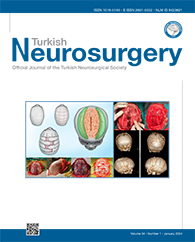2Osaka Medical and Pharmaceutical University Hospital, Department of Neurosurgery and Endovascular Therapy, Takatsuki, Osaka, Japan
3Osaka General Medical Center, Department of Neurosurgery, Osaka, Japan DOI : 10.5137/1019-5149.JTN.45181-23.3 AIM: To report mechanical thrombectomy (MT) for internal carotid artery (ICA) occlusion with cross-flow through the communicating artery (?with? group), and to compare it with ICA or middle cerebral artery occlusion without cross-flow (?without? group).
MATERIAL and METHODS: This study included 10 and 57 cases of the ?with? and ?without? groups, respectively. Cases analyzed by rapid processing of perfusion and diffusion (RAPID) since October 2020 were included.
RESULTS: Puncture-to-reperfusion time was 78.5 and 39 min (p=0.0155), the National Institutes of Health Stroke Scale score at discharge was 10.5 and 4 (p=0.0166), decline from pre to post Diffusion-Weighted Image-Alberta Stroke Program Early computed tomography (CT) Score was 0.5 and 0 (p=0.0495), and the modified Rankin Scale score at 90 days was 4 and 2 (p=0.0195) in the ?with? and ?without? groups, respectively. Furthermore, Tmax values of >6 s (50 cc vs. 164 cc; p=0.0277) and Tmax >4 s/Tmax > 6 s ratio (3.23 vs. 1.55) (p=0.0074) were significantly different between the ?with? and ?without? groups.
CONCLUSION: The ?with? group may have been affected by the longer treatment time and being at high risk of distal migration of thrombus due to poor prognosis. Although the region with a Tmax of >6 s tends to be small in patients of the ?with? group, it indicates a low-perfusion state that can lead to cerebral infarction, and MT should be performed.
Keywords : Anterior communicating artery, Cross-flow, Cardiogenic internal carotid artery occlusion, Mechanical thrombectomy




